Family : Orchidaceae

Text © Prof. Pietro Pavone

English translation by Mario Beltramini
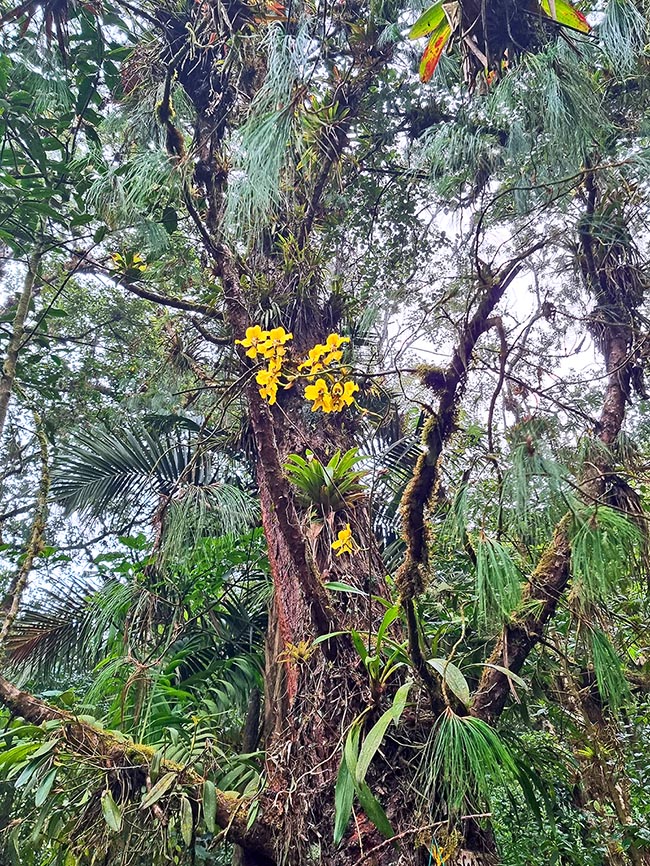
Cyrtochilum macranthum is an epiphyte of the mountain misty rainforests of Colombia, Ecuador and Peru © Monique Sancho et Jean-Luc Fasolin
Cyrtochilum macranthum (Lindl.) Kraenzl. (1917) is a species of the family Orchidaceae, subfamily
Epidendroideae, tribe Cymbidieae, subtribe Oncidiinae.
It is found in the misty mountain rainforests of Colombia (Santiago de Cali), Ecuador (Bolivar, Chimborazo, Pallatanga, Cotopaxi, Imbabura, Cotacachi, Loja, Napo, Pichincha, Quito, Tungurahua, Zamora-Chinchipe) and Peru (Amazon, Bagua, Cajamarca, Piura, Chota, Hualgavoc).
The genus Cyrtochilum was published in 1816 in Nova Genera et Species Plantarum, opus in seven volumes, from 1815 to 1825, where Alexander von Humboldt (1769-1859) and Anné Bonpland (1773-1858) brought to the knowledges of the vast public the plants collected during their long voyage begun In Colombia, in December 1801, and then in Quito (Ecuador) in the following January, where they remained until August 1802 to go on various excursions on the volcans Chimborazo (6310 m above the sea level), the highest Ecuadorian Andes peak, and Pichincha (4776 m above the sea level).
From Quito they then moved towards Peru up to Guayaquil.
During this voyage an extremely important botanical collection was realized.
In the first volume (Nov. Gen. Sp. 1:349, 1816) the German botanist Kark Sigismund (1788-1850), after having spent years studying the specimens, created the genus Cyrtochilum on the occasion of the description of two new species: Cyrtochilum flexuosum and Cyrtochilum undulatum Kunth.
The main features of the genus were to have unguiculate sepals and petals and a short convex and without spur lip. The Author, however, did not designate the type species (typus) of the genus because by that time this was not required, but this lack together with the generic description of the genus produced to Cyrtochilum quite a troubled story.
Friedrich Wilhelm Ludwig Kraenzlin (1847-1934), only many years later, recognized the Cyrtochilum as valid genus in Notizbl. Bot. Gart. Berlin-Dahlem 7:95 (1917), but not all the other scholars did accept it. In fact, as new species were discovered and described, it became more and more difficult to understand which of them to insert in Cyrtochilum and which one in the other genera having quite similar morphologic characteristics.
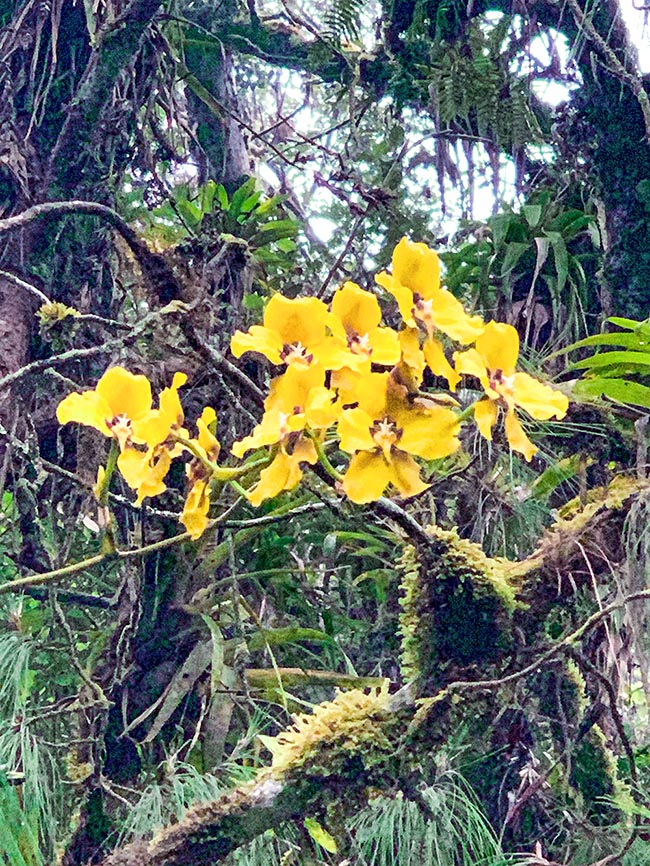
It mainly grows in the humid tropical bioma, between 2200 and 3400 m © Monique Sancho et Jean-Luc Fasolin
For this reason the majority of the taxonomists have moved the species of Cyrtochilum into the genera amply circumscribed such as Oncidium Sw. or Odontoglossum Kunth.
John Lindley (1799-1865) himself, who in his opus The Genera and Species of Orchideous Plant (1833) initially did accept Cyrtochilum, later on, in 1838, moved the two species into the genus Oncidium Sw.
In 1974 the American botanist Leslie Andrew Garay (1924-2016), curator of the Oakes Ames Orchid Herbarium (AMES) at the University of Harvard, selected Cyrtochilum undulatum as species typus of the genus.
These passages from one genus to another led to a remarkable confusion between the taxonomists.
In 2001, Stig Dalström reevaluated the genus Cyrtochilum and suggested various new nomenclatural combinations.
After this Author, the genus Cyrtochilum should include species having panicle inflorescences, flexuous and ramified, big flowers with broad and unguiculate, and narrow and thin lips covered in the basal part by broad, bulky compound callus, formed by keels and digitate segments, and partially connate with a clavate and thin gynostemium forming a right angle with the lip.
Dalström has recognized, later on, about 140 species in the genus Cyrtochilum.
After this Author, the genus includes species presently mainly from Venezuela to Bolivia from 1500 to 3500 m of altitude, with only one species, Cyrtochilum meirax (Rchb.f.) Dalström, present in the Caribbean. Other Authors, on the basis of the sequences of molecular markers, have proposed the inclusion in this genus of species belonging to other connate, mostly native to the Ecuadorian Andes, and the Colombian and northern Peruvian mountains.
Thus a monophyletic unit was created, thanks to the molecular data, but morphologically heteromorphic, that has produced quite a few problems for the description of the genus. In fact, the arrival of the molecular research, in particular of the DNA sequencing, while on the one hand has helped the taxonomists in understanding the kinship relationships between the various taxa, on the other did not give way to distinguish them visually.
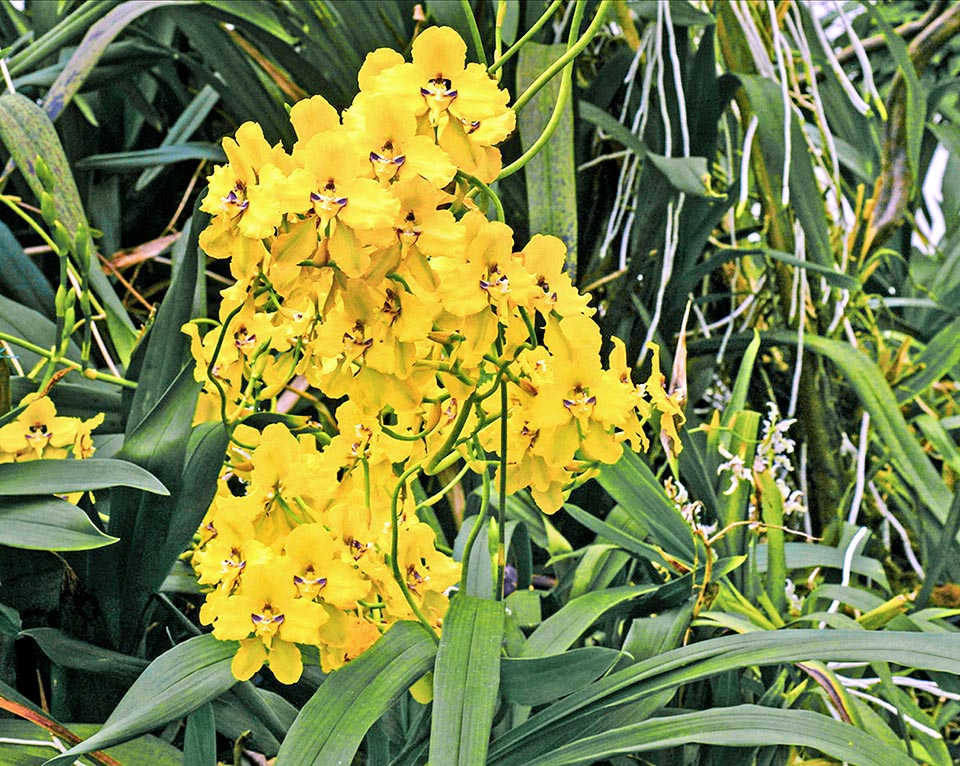
The leaves, two per pseudobulb, reach 40 cm. The inflorescence measures even 3-4 m, with intertwisted branches that may bear 70 flowers © Ron Parsons
All of this happens because also convergence phenomena do exist that often allow plants not closely related to each other to develop flowers looking similar because they stand in the presence of the same pollinators. Conversely, the plants, those closely related and growing together, may display flowers having a quite different look to take advantage of all pollinators present in the area of growth.
It must be also kept in mind that the orchids are particularly prone to hybridization because of the weakness or even of the absence of postzygotic barriers to gene exchange.
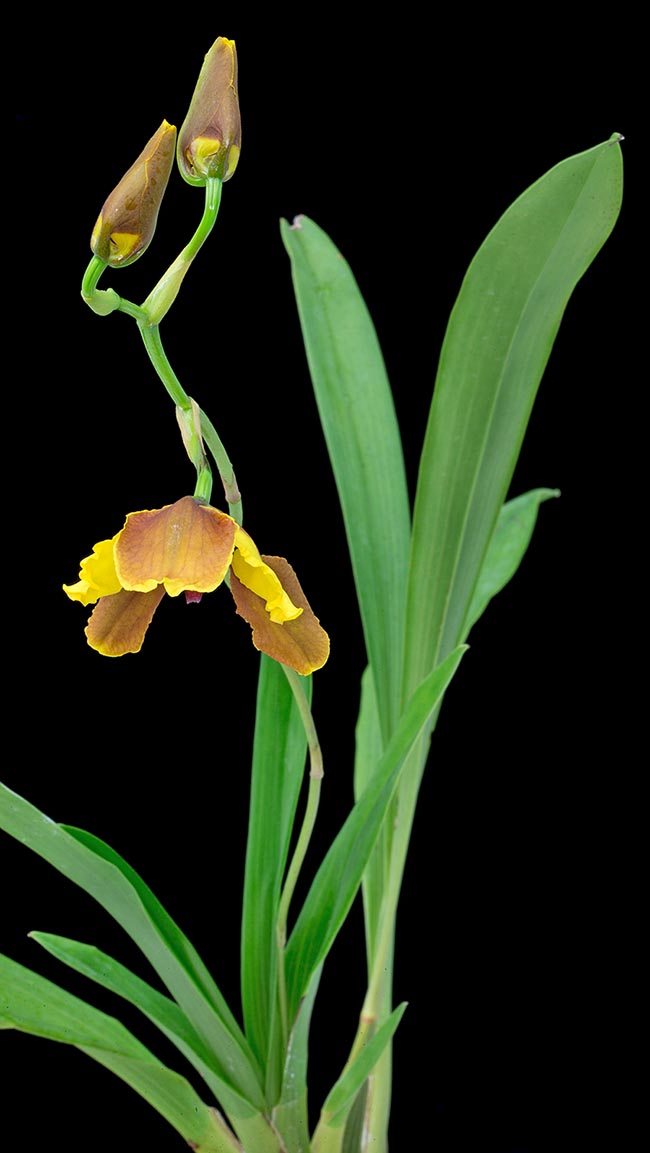
Conversely, the single branches have few flowers, from 2 to maximum 5 © Giuseppe Mazza
Many orchida rely on the prezygotic barriers, with species-specific flowers, that is trusting on the preference of the pollinators.
However if the same pollinators visit plants that usually grow in the same area and have overlapping blooming periods and non-specific pollination, though depending on different species, they can produce gene fluxes between them altering the morphological characters and consequently the characteristics of the flower for proper recognition.
As a consequence when the species are put together on the base of the only floral resemblances without respecting their genetic background, we risk creating polyphyletic groups, hence not natural, with ancestors not related to one another.
The disagreement among taxonomists, still continuing today, on how to treat this vast group of plants (Oncidiinae) has obliged various Authors to consider necessary the combination of the molecular data with the morphological ones.
So, for a correct systematics of the genus Cyrtochilum will be necessary further data concerning the influence of the horizontal gene transfer, the hybridization and the polyploidy in order to eliminate the inconsistency between the set of molecular and morphological data.
When will be available a better comprehension of the correlations between the species of the complex Cyrtochilum–Oncidium–Odontoglossum will be possible to utilize the morphological characteristics for finding a way to distinguish visually the different species between them and to place them in the natural pertinent groups.
Cyrtochilum macranthum is epiphyte or terricolous caespitose of great size growing mainly in the humid tropical bioma at altitudes between 2200 and 3400 m.
The name of the genus is the combination of the Greek adjective “κυρτός” (cyrtós), convex and of the substantive “χεῖλος” (cheilos), lip, with reference to the shape of the labellum.
The specific epithet is the combination of the Greek adjective “μακρός” (macrόs), big and of the substantive “ἄνθος” (anthos), flower, with reference to the size of its flowers. As a matter of fact, its common name is “Great flower Cyrtochilum”.
Cyrtochilum macranthum has a creeping rhizome with up to 10 cm long and 4 cm broad pseudobulbs, ovoid in shape, slightly compressed, wrapped at the base by 3 to 4 imbricate sheaths and bearing two apical leaves, linear, acute, oblong to oblanceolate, up to 40 cm long and 5 cm broad.
The inflorescence originates from a just ripe pseudobulb through the axilla of the basal sheath. It is bristly, paniculate, up to 3(4) m long, with intertwined and climbing branches and with few flowers per branch (2 to 5) but totally up to 70.
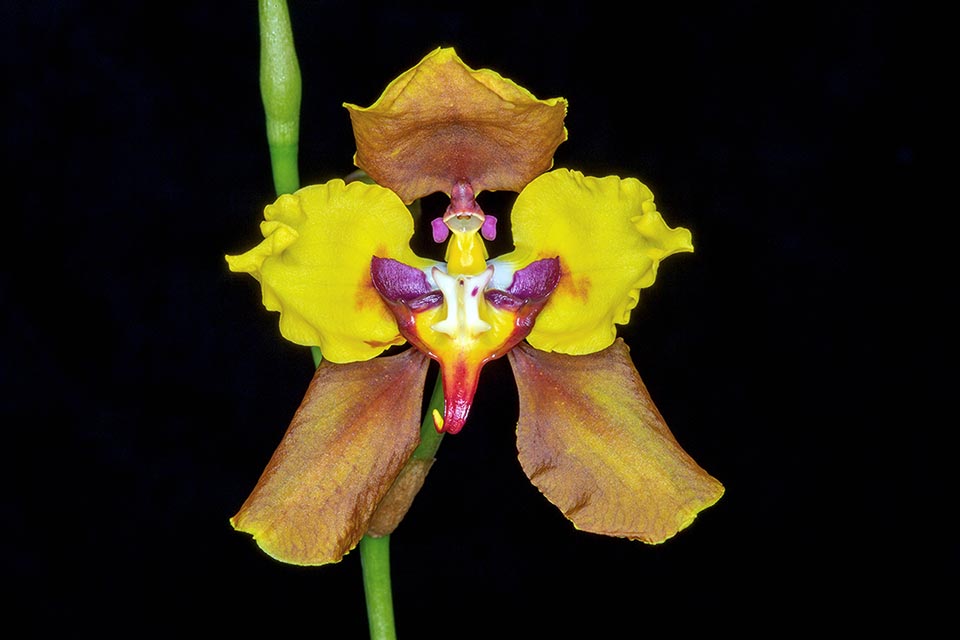
The long-lasting flowers measure about 6 cm. They have yellow or intense bronze sepals and bright yellow petals suffused brown © Giuseppe Mazza
The flowers are resupinate, big with yellow to intense bronze colour, bright yellow petals suffused with brown.
The labellum is of variable colour from lilac to purple colour with yellow median lobe, white and purple callus with the two protuberances that widen and are somewhat falcate. The floral bracts are 25-30 mm long.
The dorsal sepal has an about 5-10 mm long claw, narrow, canaliculate, with elliptic, rhomboid wings just over the base and almost round lamina (27-35 mm per 24-30 mm) with margin irregularly wavy and rounded apex.
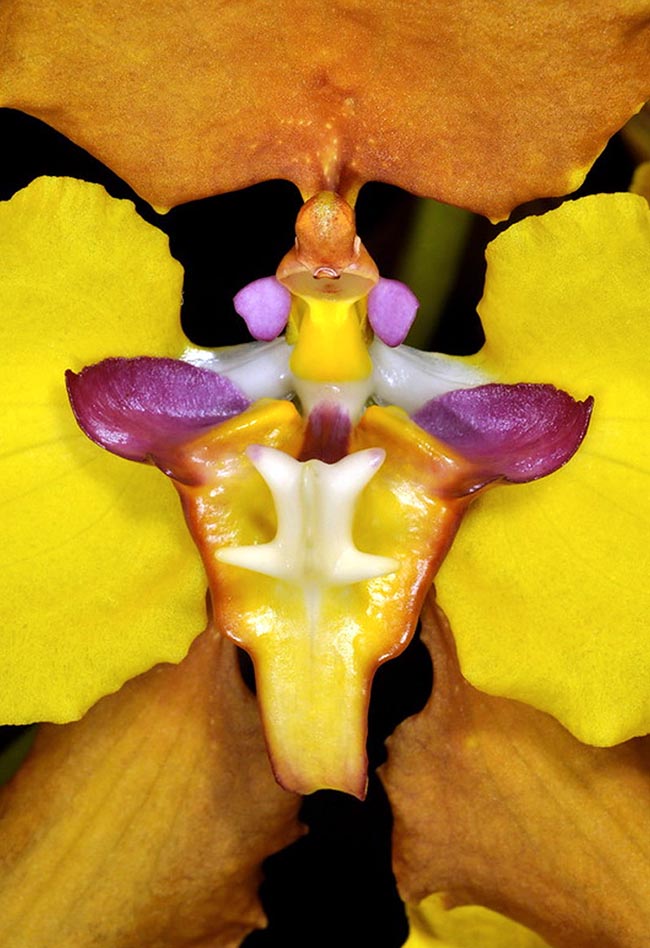
The labellum, triangular and convex as Greek generic name states, is of colour varying from lilac to purple with yellow median lobe, white and purple callus with the two protrusions widening and rather falcate © Ron Parsons
The lateral sepals have an 8-15 mm long claw, narrow, with basal wing on the outer margin; up to 35 mm long lamina, rounded at the base, sub obtuse at the apex and with little wavy margins.
The petals have an about 3-5 mm long claw, slightly winged at the base.
The lamina is about 40 mm long and 35 mm broad, of elliptic-ovate shape, truncated at the apex, with subcordate base and slightly wavy margins.
The labellum is 18 to 30 mm long and 12 to 23 mm broad, with a triangular outline, truncated-subcordate base, convex at the centre and prominent callus, shaped like a keel raised at the keel.
The gynostemium is about 10 mm long, merged at the base to the labellum with lateral appendages that do not reach the base of the anther.
Pedicel and ovary are both up to 65 mm long.
The bloomings are long lasting (about 30 days) and occur from autumn to spring, even late.
The pollination is done by Bombus hortorum (Linnaeus, 1761) and by bees of the genus Centris.
The photosynthesis is of CAM (Crassulacean Acid Metabolism) type, executed as an adaptation to the excessive loss of water.
In this way the process of photosynthesis occurs with closed stomata that, conversely, open during the night for the gas exchanges (CO2, O2) with a minimum waste of water vapour.
Cyrtochilum macranthum is a commercially protected species and as such it is inserted in the Appendix II of Washington Convention (CITES) that has the aim to protect the animal and vegetable species under risk of extinction forbidding their export and detention.
This species reproduces by seed, by division of the plant with at least 3-4 pseudobulbs. It can be reproduced in vitro and also from unripe seeds (still green capsules) placed in right growing soil. The germination in this way is obtained in less time, averagely, 91,78 days, in respect to the time necessary for the germination of the ripe seeds. In this manner it also reduces the time for the transplanting obtaining a great number of plants in a short time.
The. cultivation of Cyrtochilum macranthum is similar to that of Cyrtochilum serratum.
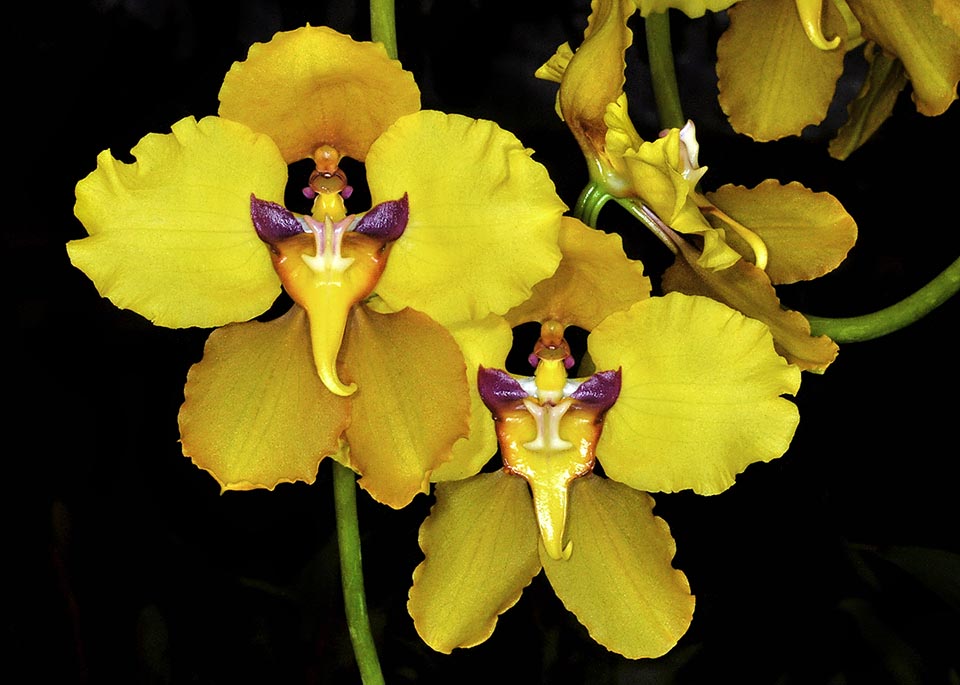
Cyrtochilum macranthum ‘Pacifica’ is a variety awarded in 2005 by the American Orchid Society © Ron Parsons
They are plants requiring a slight shade, cool temperatures, with winter minimum temperatures not under the 12 °C and summer maximum not over 26 °C, high humidity, 60-70%, and good ventilation.
The waterings must be regular during the pseudobulbs period of growth, being careful to leave the substratum to dry up before giving water again. In winter the waterings are to be reduced. The water must be rainwater or obtained through reverse osmosis or demineralized.
Fertilizations must be done during the vegetative period utilizing orchid fertilizer withmicroelements, in the measure of a third of the dose suggested on the package.
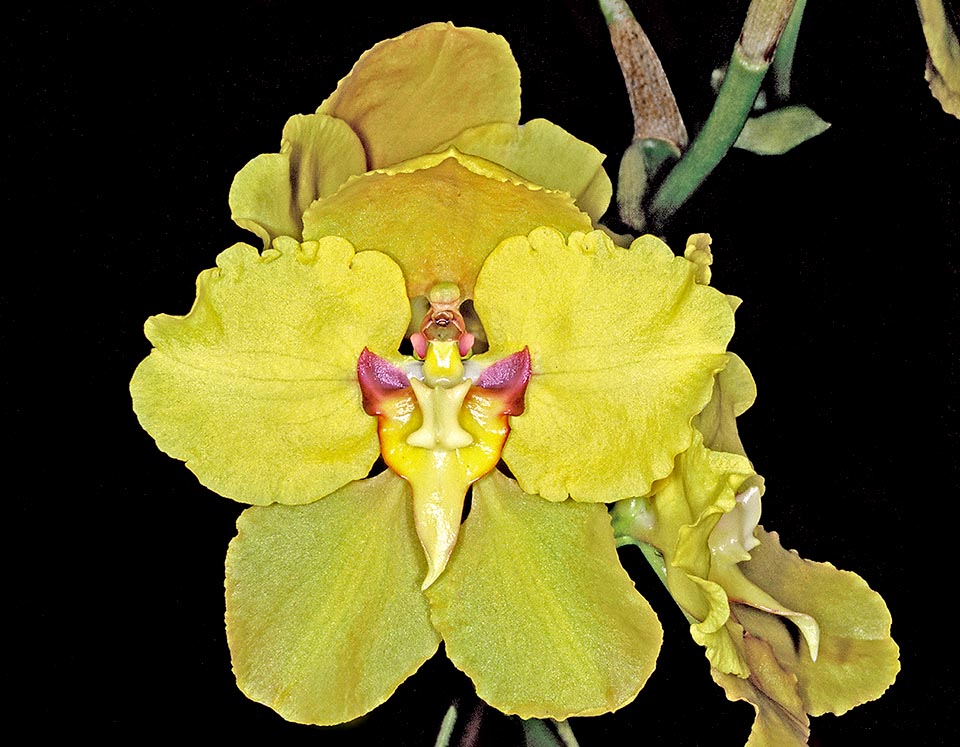
Also Cyrtochilum macranthum h.v nanum ‘Memoria Henry Ho Hur’ got in 2006 a similar recognition by the American Orchid Society © Eric Hunt
The plants can be cultivated in pots with a draining and aerated compost, mounted on bark or on a cork raft. The repotting must be done at the time of the vegetative restart when the roots begin to form.
Several hybrids of Cyrtochilum macranthum exist, some of them even intergeneric.
× Odontocidium is an artificial intergeneric hybrid (nothogenus) obtained through the cross between a species of the genus Odontocidium and one of the genus Oncidium. It is a great group of orchids where there are present many hybrids of the two genera that in turn have been crossed to produce other hybrids.
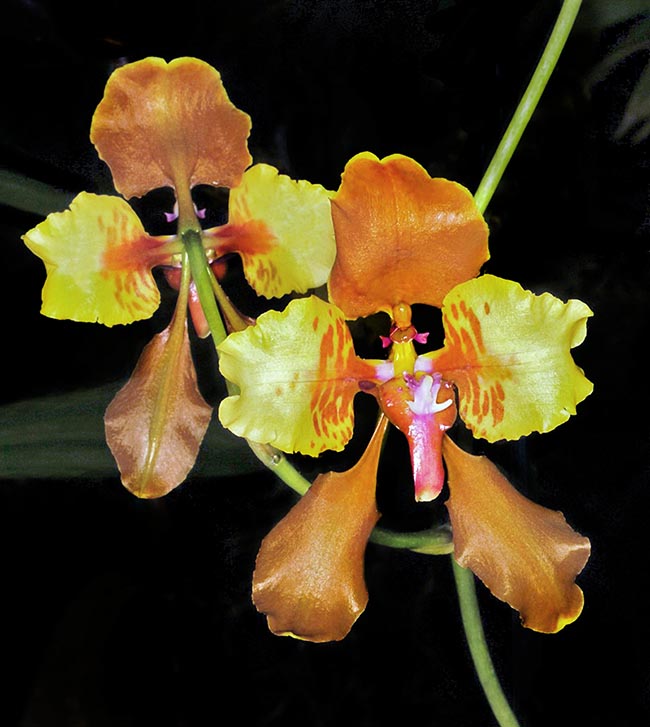
Cyrtochilum McBeanianum is a 1913 famous hybrid born from the cross of Cyrtochilum macranthum x Cyrtochilum halteratum in McBean’s Orchids nursery. It has originated prestigious varieties like the one we shown here © Norbert Dank
Among all intergeneric, the hybrids Odontocidium are the most diffused due to the beautiful varieties of shapes and colours that can be obtained.
The flowers, in fact, may be yellow, white, violet, brown and of various combinations of these colours.
Cyrtochilum × monacranthum, (Andreetta ex Dodson) J. M. H. Shaw 2002 (Kew).
Natural hybrid native to Ecuador between Cyrtochilum eniculatum × Cyrtochilum macranthum.
This hybrid was described for the first time by Angel Andreetta (1920-2011) and Calaway Homer Dodson (1928-2020) as Oncidium × monacranthum, but its present name is due to Julian Mark Hugh Shaw (1955-).
It is a natural hybrid of big size found in Ecuador between 2000 and 2600 metres of altitude.
It blooms in spring with a panicle inflorescence up to 2 metres long, with single branches from 3 to 5 flowers and up to 25 cm long.
In cultivation this hybrid must stand in partial or complete shade and the temperature must not drop under 10 °C and exceed 26 °C.
The plants must be maintained humid with short dry periods (water about once a week).
In winter the irrigation must be reduced (water about once every 10 days).
The historical hybrid Cyrtochilum McBeanianum, is a cross of Cyrtochilum macranthum × Cyrtochilum halteratumobtained in 1913 at the nursery McBean’s Orchids, the oldest in the UK.
The owner James McBean began to cultivate plants coming from South America in 1879 and when he did discover the beauty of the orchids, together with his son Albert, began to reproduce them to provide them to the British Royal family on the occasion of special events.
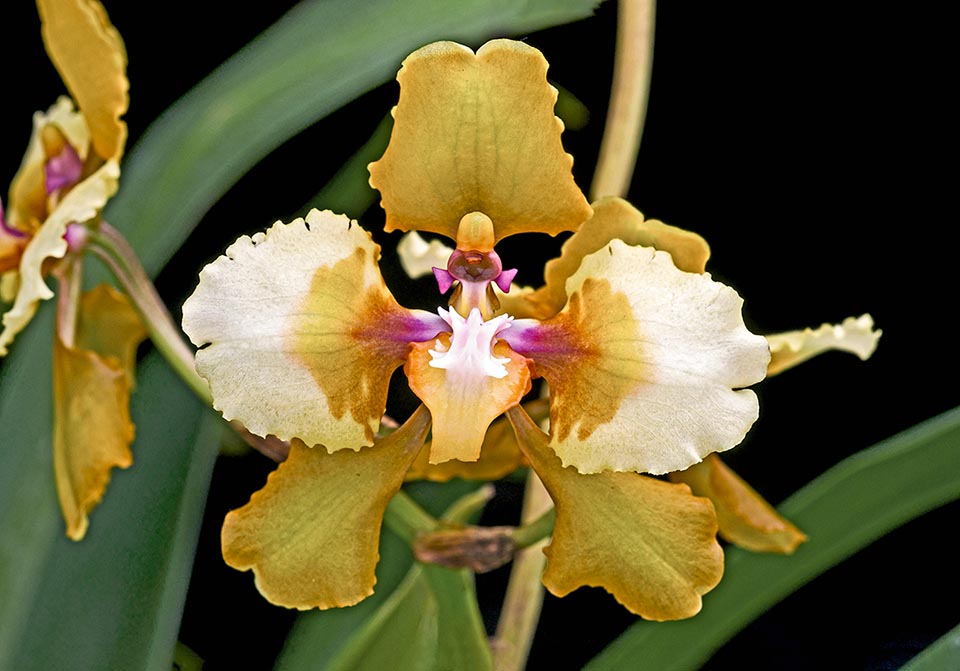
In 2009 the variety Cyrtochilum McBeabianum ‘Golden Gate’ obtained by Golden Gate Orchids, got a special award from the Peninsula Orchid Society © Eric Hunt
In 1913 he attended the Chelsea Flower Show of the Royal Horticultural Society winning, even over the years, more than 70 prestigious gold medals.
In 2014 the nursery was about to close but Rose Armstrong and Tom Dixon, have financed it in order to guarantee its survival also thanks to the experienced Valeria Valkova and the large team of volunteers.
The natural hybrid Cyrtochilum Rustic Sunset is a cross of Cyrtochilum serratum × macranthum and registered on 22/04/1996 by H. Liebman at the Royal Horticultural Society. It is a primary hybrid because it is the fruit of cross between two species.
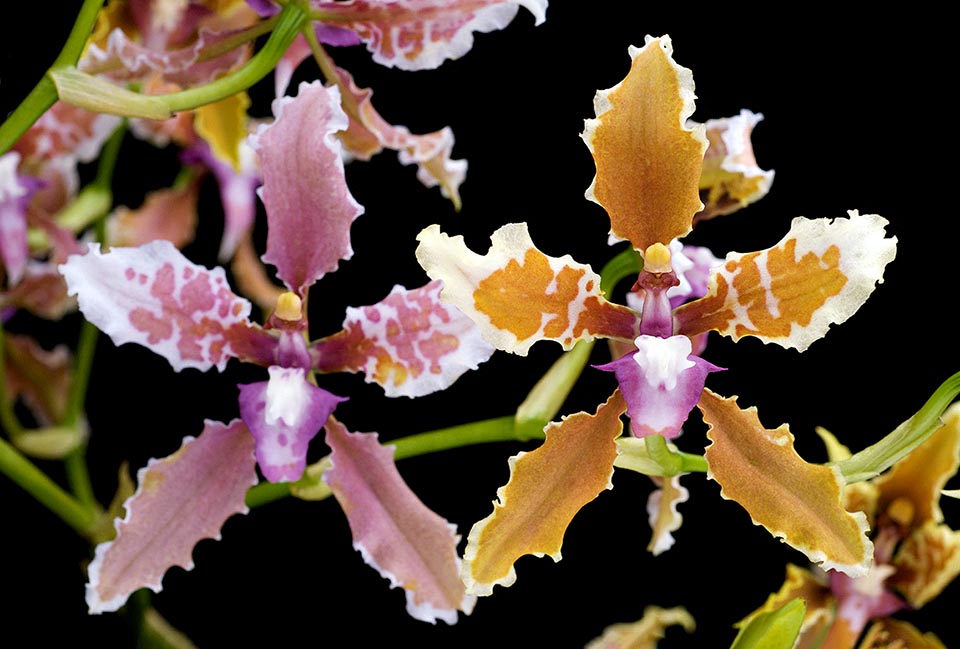
The flower of Cyrtochilum macranthum x Cyrtochilum ramosissimum initially is yellow then turns pink © Eric Hunt
A medium-sized hybrid is the cross between Odontoglossum kegeljani × Cyrtochilum macranthum that in cultivation requires day temperatures of 21-25 °C and by night 13-19 °C, high humidity, average air flow, good light, but not excessive or direct, and a fertilization every 15 days.
Cyrtochilum La Cholais a primary hybrid created by P. Tosi in 1999 by cross between the two species Cyrtochilum loxense and Cyrtochilum macranthum.
Cyrtochilum Cuidad de Loja,M. Portilla 2016 (RHS) is a hybrid obtained by crossing Cyrtochilum retusum × Cyrtochilum macranthum. It presents beautiful pale orange coloured flowers on a ramified inflorescence. The name given to it is for celebrating the floristic biodiversity of the Province of Loja (Ecuador).
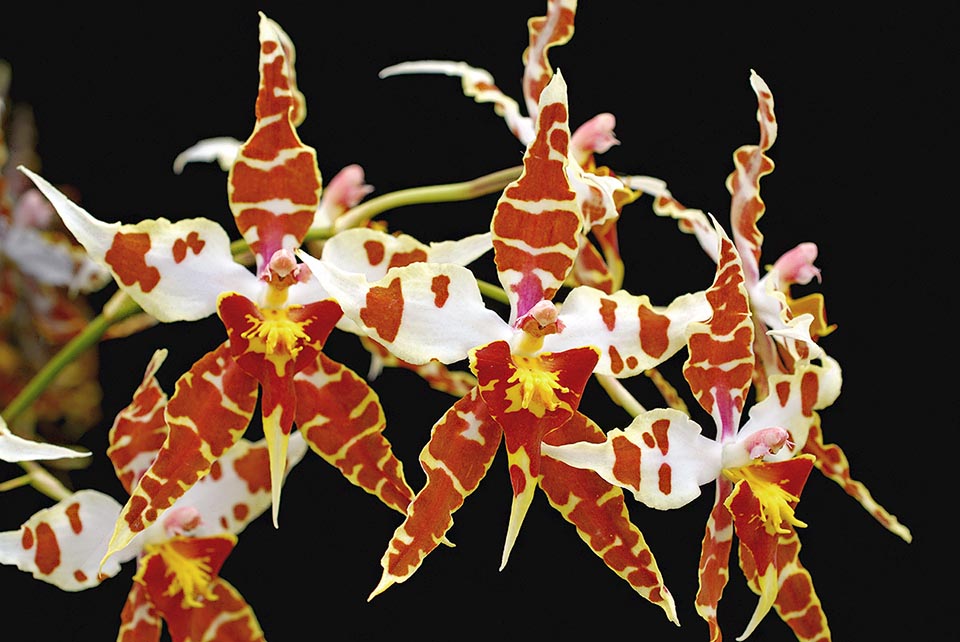
Cyrtoglossum Ecuador is an amazing intergeneric hybrid obtained from cross between Odontoglossum cirrhosum and Oncidium macranthum now Cyrtochilum macranthum © Eric Hunt
Many are the award-winning cultivars. The most recent are: Cyrtochilum macranthum ‘Jardin botanique de Montréal’ (2018); Cyrtochilum macranthum ‘Monster’ (2017); Cyrtochilum macranthum ‘Andrea Niessen’ (2014); Cyrtochilum macranthum ‘Marsh Hollow Magic’ (2014); Cyrtochilum macranthum ‘Marsh Hollow Jewel’ (2014); Cyrtochilum macranthum h.v. nanum ‘Alfons’ (2013); Cyrtochilum macranthum ‘Golden Sunrise’ (2013); Cyrtochilum macranthum ‘Golden Sunset’ (2013); Cyrtochilum macranthum ‘Rustic Sunrise’ (2012); Cyrtochilum macranthum ‘BUSTER’ (2012); Cyrtochilum macranthum ‘Rustic Perfection’ (2012); Cyrtochilum macranthum ‘George Norris’ (2011); Cyrtochilum macranthum h.v. nanum ‘Solar Place’ (2006); Cyrtochilum macranthum ‘Pacifica’ (2005); Cyrtochilum macranthum ‘Golden Globe’ (2005); Oncidium macranthum h.v. nanum ‘Memoria Henry Ho Hur’ (2004); Oncidium macranthum ‘Pacific Gold’ (2004); Oncidium macranthum h.v. nanum ‘Full Moon’ (2003); Oncidium macranthum ‘Rustic Seven’ (2002); Oncidium macranthum ‘Rio Verde’ (2002).
Synonyms: Oncidium macranthum Lindl. (1833); Cyrtochilum carrutherianum F.Lehm. & Kraenzl. (1922); Cyrtochilum hastiferum (Rchb.f. & Warsz.) Kraenzl. (1917); Oncidium hastiferum Rchb.f. & Warsz. (1854); Oncidium macranthum var. hastiferum (Rchb.f. & Warsz.) C.Schweinf. (1949).
